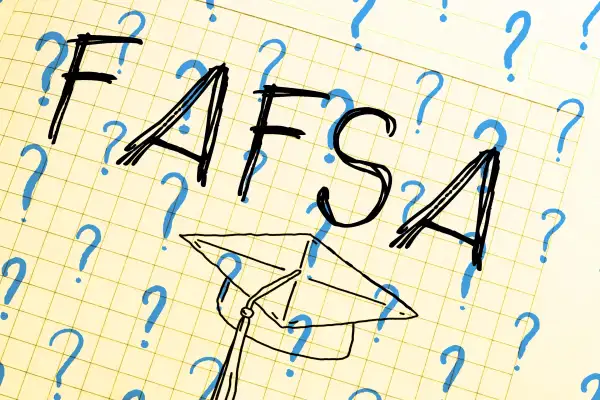Will the FAFSA Be Delayed Again? College Experts Are Worried

The FAFSA saga might not be over yet.
Short for the Free Application for Federal Student Aid, the FAFSA for the 2024-2025 academic year experienced several unprecedented delays, forcing dozens of colleges to push back enrollment-decision deadlines and some students who depend on financial aid to put their college plans on hold.
Now, 25 financial aid and higher-education organizations are sounding the alarm to avoid a repeat. In a letter sent to the U.S. Department of Education on Monday, the groups warned that the release of the FAFSA for 2025-2026 could be postponed as a result of this year’s technical and administrative issues.
“We are concerned that the FAFSA will be delayed again,” the organizations wrote, “and that the release date will remain uncertain until just before the form becomes available.”
The letter underscores that the Education Department is already behind on releasing a draft of the upcoming FAFSA for public comment. Usually, the draft is released in February and the final form is publicly available on Oct. 1 for the following year.
The Education Department says it's still preparing for an October launch, though advocates are dubious. With less than four months to go and no draft in hand, the organizations urged Education Secretary Miguel Cardona and the department to better communicate the FAFSA timeline, writing that “transparency for next year will be critical.”
What’s (still) going on with the FAFSA?
The FAFSA, often lamented as difficult and time-consuming, recently underwent a drastic simplification mandated by the FAFSA Simplification Act, a law tucked into a sprawling pandemic-era stimulus package signed by former President Donald Trump in 2020.
For the 2024-2025 form, the FAFSA shrunk from over 100 questions to less than 40. In addition to changes on the form itself, the Education Department altered the methodology it uses to determine financial assistance, which it says resulted in about 650,000 new students becoming eligible for aid.
Millions of parents, students and college workers know what happened next: The rollout of the simplified form was riddled with delays, errors and technical glitches. Typically released on Oct. 1 of the previous year, the 2024-2025 FAFSA did not officially launch until Jan. 8, 2024 — three months behind schedule.
That set off a chain reaction of problems for families, the government and college administrators. Several technical glitches with the new form as well as behind-the-scenes issues with the aid formula spurred further delays. Colleges didn’t start receiving students’ financial aid information until March, with many students not receiving their award letters until weeks later. This bumped up against, and in some cases pushed back, the traditional May 1 college-decision deadline.
In the meantime, the Education Department was supposed to have been gearing up for the release of the 2025-2026 FAFSA. Now that it's four months behind on releasing the draft of the upcoming FAFSA, higher education experts and administrators are getting a sense of déjà vu.
FAFSA delays have major effects for families and colleges. Each year, about 20 million students fill out the form in hopes of obtaining grants, scholarships or loans to help them afford college. Often, prospective students can’t commit to enrolling at a particular college unless they know how much it is going to cost them.
According to the letter from higher ed advocates, FAFSA applications this year are down 13.5% due to the botched rollout.
“This drop is twice the magnitude of the FAFSA completion decline that occurred during the pandemic, which portended a 7.4% drop in college enrollment,” they said.
Aiming to avoid another 'absolute disaster'
College administrators are crossing their fingers that the Education Department will be able to put out the 2025-2026 FAFSA on time in October despite the current delay with the draft version of the form.
When Money asked the Education Department to comment on the letter and the FAFSA timeline, the agency said in an emailed statement: "We have heard from students, families, institutions, states, and those that support them that it is most important for the 25-26 FAFSA form to launch in October. Consistent with the Secretary’s statements, the Department is working towards that goal.”
Previously, the department pinned the blame for the delays on Congress, stating that lawmakers declined its request for a $600 million budget increase to help the agency implement the drastic changes to the FAFSA, among a host of other initiatives including the implementation of a new income-driven repayment plan called SAVE and developing new student-loan servicer contracts.
"We are certainly working under very substantial workload demands created by Congress and without additional resources," an Education Department official told reporters earlier this year.
For the 2025 fiscal year (starting on Oct. 1 for the federal government) the Education Department requested an additional $625 million for the office that oversees the FAFSA.
It’s not clear whether — or when — Congress will grant that request. Lawmakers are far behind schedule themselves. Typically passed before the fiscal year begins, this year’s federal budget did not get approved until March, five months later than usual, narrowly avoiding a government shutdown.
In a recent House budget hearing, Republican lawmakers expressed concern about the Education Department's request for additional funding.
“The new FAFSA has been an absolute disaster,” said Rep. Julia Letlow, R-La., noting that the department already has about 1,400 full-time employees working in the office that oversees the FAFSA. She pressed Cardona, the education secretary, about allocating too many employees to student loan forgiveness efforts and not enough to fixing the FAFSA.
“There’s nothing more important right now at the Department of Education [than the FAFSA],” Cardona responded. “We're working on this around the clock.”
Following the botched FAFSA rollout, Richard Cordray, who oversees the department’s Federal Student Aid division, announced he would step down. He is expected to stay on through the end of June. The Education Department has not yet announced his replacement.
More from Money:
These Are the 745 Best Colleges in America
Navient Is Quietly Forgiving Private Student Loans Amid Pressure From Lawmakers
Biden's New Student Loan Forgiveness Plan Could Cancel $150 Billion of Debt







